Subaru used to have its market niche mostly to itself – because (for many years) almost no other car manufacturer made cars (sedans and wagons) with all-wheel-drive and enough ground clearance to go where you generally needed a 4×4 SUV to go.
Now almost no one makes cars – and every brand sells crossovers with (or that at least offer) all-wheel-drive and enough ground clearance to go places you used to need a 4×4 SUV – or a Subaru – to get to.
So where does that leave Subaru?
There’s brand loyalty, of course. Just as there are Ford and Chevy people, there are Subaru people – who like (and buy) Subarus because they are Subarus.
And then there are Subarus like the Outback. Which is also a wagon (rather than a crossover) and that’s one thing that’s still different or – at least – unusual.
Also the Subaru’s unusual kind of engine.
It’s enough to keep this Subaru going.
What It Is
The Outback is a mid-sized wagon with standard all-wheel-drive and a standard boxer (or flat four) engine – as opposed to the usual in-line (and upright) four cylinder engines that come standard in most crossovers.
Prices start at $28,995 for the base trim, which has a 2.5 liter boxer engine paired with a continuously variable (CVT) automatic transmission. A more powerful (but slightly smaller) 2.4 liter turbocharged boxer engine is standard in XT and Wilderness trims; the latter also comes standard with almost 10 inches of ground clearance and different version of the CVT/AWD system with lower gearing, to provide extra leverage similar to that of a 4WD system’s two speed transfer case, plus skid plates and 17 inch wheels with all-terrain tires.
A top of the line Touring XT with the turbocharged engine, heated leather seats (and steering wheel) as well as a 12 speaker Harman Kardon audio system and a sunroof stickers for $42,795.
What’s New
Other than a few minor trim tweaks and shuffling of standard/optional equipment, the Outback carries over into 2024 mostly unchanged.
What’s Good
Wagons aren’t what everyone else is driving.
Wagons have lower rooflines (making it easier to load things on the roof).
Boxer engines have their own unique personality.
What’s Not So Good
Automatic (CVT) only.
Turbocharged engine only available in the more expensive XT and Wilderness trims, which all start about $9-$10k higher than base and next-up Premium trims.
Badgering “driver assistance” systems.
Every Outback comes standard with something you can’t get in any other make/model vehicle that isn’t a Porsche:
A boxer – or horizontally opposed – engine.
This type of engine is also known as a flat engine, because its cylinders lay flat rather than in a line (or a “v”). Subaru’s boxer engines are flat fours (Porsches are flat sixes) meaning that there are two cylinders on one side and two on the other side. These box each other across the centerline of the engine’s crankshaft.
What are the advantages of this layout?
The engine is flat – which means it sits lower in the car. Generally speaking, getting the weight of the engine closer to the road improves a car’s balance. And distributing the weight of the engine evenly on either side of the car’s centerline (front to rear) improves handling. This is one reason why Porsche sports cars like the 911 have flat/boxer engines. And Subarus with the same type of engines benefit from the same.
Flat/boxer engines are also – generally – lighter than upright engines because they are naturally balanced and so don’t need heavy crank balancers to dampen what would otherwise be noticeable vibrations. This reduction in the weight of the reciprocating assembly also usually means an engine that revs faster and higher – another reason why Porsche uses this type of engine. Also, they make a uniquely growly sound.
What are the disadvantages?
If the engine lays flat, the oil may not fully drain back into the sump when the engine isn’t running and that can lead to excessive oil consumption (in the cylinders) resulting from oil collecting around intake/exhaust valve guides and so on. Keeping up with oil changes (and using the right oil) will usually prevent this problem from developing.
The Outback is available with either of two four cylinder boxer engines. The standard 2.5 liter engine makes 182 horsepower at 5,800 RPM and 176 ft.-lbs. of torque at 4,400 RPM. It is paired with a continuously variable CVT automatic transmission and Subaru’s “symmetric” all-wheel-drive system, which can route engine power side-to-side as well as front-to-back. The latter (which is what most other manufacturer’s AWD systems do) improves traction by routing power from slipping front wheels to rear wheels that have more . . . traction. The former (side-to-side) improves handling by correcting for under-and-oversteer during cornering, by applying power to the inside (or outside) wheels.
The optional engine is a smaller (2.4 liter) boxer four that’s turbocharged; this one makes 260 horsepower at 5,600 RPM and 277 ft.-lbs. of torque at 2000 RPM. It’s also paired with the CVT automatic and AWD.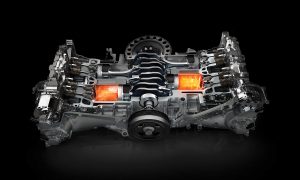
Interestingly, there’s very little gas mileage difference between the standard 2.5 liter four and the optional 2.4 liter turbo’d four. The latter rates 22 city/29 highway; the former 26 city, 32 highway.
But there is a big performance difference. The base-engine Outback needs about 8.7 seconds to get to 60 while an Outback equipped with the stronger 2.4 liter turbo’d engine can make the same run in about 6 seconds.
There’s also another difference.
Outbacks with the 2.5 liter engine are rated to pull up to 2,700 lbs. Outbacks with the 2.4 liter engine are rated to pull 3,500 lbs.
The Outback, like pretty much all new vehicles, is easy and pleasant to drive. But it could be more fun to drive. Especially versions equipped with the standard 2.5 liter engine – which isn’t especially strong but is pretty revvy. Recall that it makes its peak power at just-shy of 6,000 RPM. It would be fun to be able to work the gears getting it there (and back) 5-6 times during a 0-60 run or even from stop light to stop light.
Alas, there are no gears to work; no clutch to play with, either. Just put the CVT in Drive. It doesn’t shift, because it has no gears. You can pretend to, though – via the eight stepped ranges that Subaru programs into this transmission.
So, you push on the gas pedal and the engine’s revs increase – but there’s not much to do other than watch the progression – which is less fun than being part of the progression. It used to be more fun, in a very meaningful way, to drive a car like this without the optional (and much stronger) engine but with a manual transmission.
To have fun in this Outback (on the road, that is) you’ll probably want one with the optional turbo’d 2.4 liter engine, which makes up for the boring-as-wallboard CVT with the horsepower that’s lacking in Outbacks with the 2.5 liter engine.
It’s not just the horsepower difference that makes the difference. Note how much sooner (in the powerband) the 2.4 liter engine makes its peak horsepower – and torque. This is an engine that doesn’t need to rev to be fun and that’s why driving an Outback so equipped isn’t as boring as looking at wallboard.
Even if you don’t get the 2.4 engine, you will get the excellent AWD system that endows this Soobie with impressive sideways tenacity. This is a different kind of fun that’s absent from other AWD transportation appliances – and it’s standard in the Outback.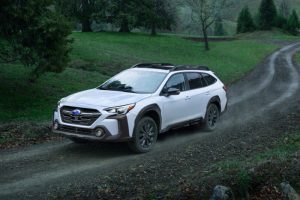
There is also fun to be had when people who drive other AWD appliances get nervous – because it’s snowing or looks like it might. Or because the road has ended.
Wilderness models of this Soobie have 9.5 inches of ground clearance but even the base Outback still has 8.7 inches and that (along with the AWD) will make you feel confident because it can carry you over the snow and through mud/standing water that would not be fun to try to wade through in a lesser vehicle.
One thing that’s not fun about this vehicle – with either engine – is the “safety” technology, especially the “distracted driver” system that tracks eye movements and sounds the alarm if it thinks you’re not paying attention to the road ahead. The problem is the system gets upset if it sees you paying attention to the sides. Glance left/right too often – to see what’s possibly entering your driving circle – and the system will flash an “eyes on the road!” warning in the main instrument cluster, along with a chime. Both can be distracting in and of themselves.
And both can be unwarranted, which is the real beef.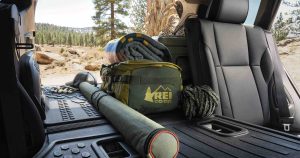
Looking ahead is – generally – sound policy. But it is also sound to look around. This system seems to encourage one – but not the other.
An Off button would be welcome.
At The Curb
Wagons used to be the alternative to sedans – for those who didn’t want a truck (or an SUV based on one). This was also before there were crossovers – which became the alternative to SUVs based on trucks.
Subaru’s wagons have survived through these evolutions, probably because Subaru buyers love Subaru wagons like the Outback. It is better-known than the steakhouse chain that uses the same name.
Probably because it’s meatier.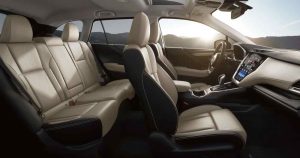
This one has always had an extra measure of capability in addition to the versatility that people buy wagons for. Others have begun to imitate the look of that capability, too – offering their own takes on the lifted/roof-racked/fender-flared, ready-to-go-anywhere stance of the Outback.
Which, as you probably know already, is also a mid-sized wagon now (rather than the compact-sized wagon based on the Impreza sedan that it was). The current model is a sibling of the Legacy sedan and shares a common underlying platform and drivetrains. But it has what the Legacy doesn’t – room for several times more than what will fit in the Legacy’s 15.1 cubic foot trunk. The Outback’s wagon layout offers an SUV-like 75.6 cubic feet of cargo carrying capacity with its back seats down – and even with them up you still have 32.5 cubic feet behind the back seats, or more than twice as much space for stuff as in the Legacy’s trunk. 
The Outback also comes standard with Hill Descent Control and fog lights, as well as 8.7 inches of ground clearance (the Legacy has 5.9 inches and so sits several inches closer to the ground).
You can get additional driver-selectable off-road modes by opting for the Onyx Edition, which also comes with water-repelling seat covers and larger (18 inch wheels). The Wilderness trim gets an upgraded roof rack rated to handle up to 700 pounds, as well as the mechanical/functional upgrades mentioned earlier, which includes increased leverage for slogging through deep, unplowed slow and mud, etc.
Premium, Limited, Touring and Wilderness trims get a larger (11.6 inch) LCD touchscreen that’s easier-to-use while driving because it has larger icons that are easier to accurately tap while driving. There are also (thankfully) still rotary knobs on either side to make volume/channel adjustments.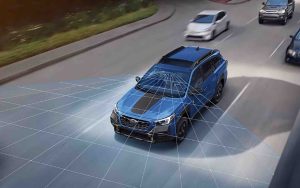
The Rest
In addition to dropping the option to go with the manual transmission that was once available in the Outback, Subaru has also made its Eyesight suite of “safety assists” unavoidable as they come standard in all trims. This includes the “drowsy/inattentive driver” nanny that gets bothered when you’re not looking directly ahead rather than looking around.
It’d be interesting to see how many buyers would opt for this – if they still could.
The Bottom Line
The Outback would be more fun if you could still get it with a manual – and without the Eyesight nanny. But it does still offer things you can’t get in other wagons – and that’s probably enough to keep the wheels turning.
. . .
If you like what you’ve found here please consider supporting EPautos.
We depend on you to keep the wheels turning!
Our donate button is here.
If you prefer not to use PayPal, our mailing address is:
EPautos
721 Hummingbird Lane SE
Copper Hill, VA 24079
PS: Get an EPautos magnet or sticker or coaster in return for a $20 or more one-time donation or a $10 or more monthly recurring donation. (Please be sure to tell us you want a magnet or sticker or coaster – and also, provide an address, so we know where to mail the thing!)
If you like items like the Keeeeeeev T shirt pictured below, you can find that and more at the EPautos store!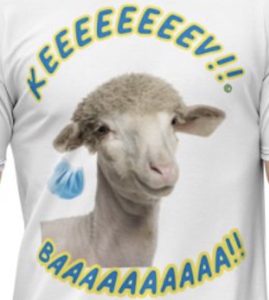



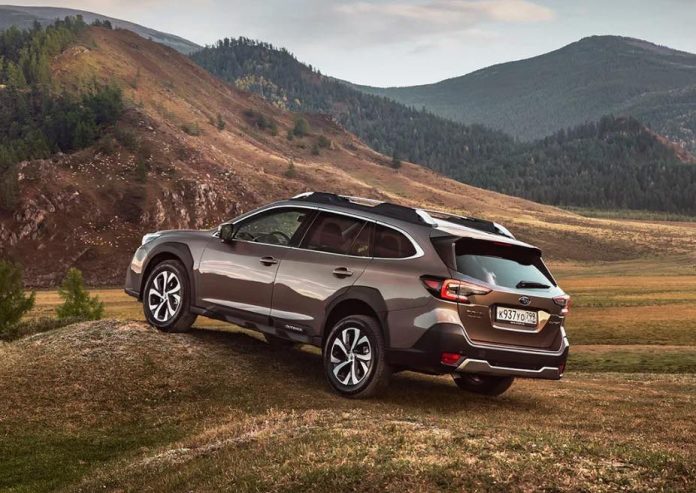

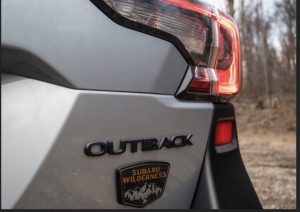










A friend has an old 1979 Subaru with 700k miles. Engine and manual tranny are original. He is an excellent mechanic.
I just crossed 4,000 miles on my 2024 Outback Wilderness, and here’s a few observations to flesh out some of what you mentioned.
1. Not all trims come with the eye monitoring nanny. It’s a thin, horizontal strip of black plastic above the radio and below the center speaker on the dash that’s perhaps 8 inches wide or so. The Wilderness trim doesn’t have it, and it may be the highest optioned trim that doesn’t.
2. All trims come standard with “Eyesight” safety stuff. This consists of two, sometimes three, cameras mounted against the upper windshield behind the rear view mirror looking out onto the roadway that provides stereoscopic vision for the car computer permitting both adaptive cruise control (instead of radar based systems in most cars), lane departure assist, and a lot of safety warnings. The problem is that Subaru, probably more than any other modern make except maybe Volvo, prides itself on safety. So they’ve cranked the sensitivity up to eleven. This has it auto-braking and beeping at me fairly regularly when I try to pull into traffic at anything faster than an octogenarian with a walker. Don’t dare try to back into a parking spot at a normal speed, or it will slam on the brakes six feet from the bumper of the car behind you (or the bush, or even the curb). The rear parking sensors are ultrasound, like most car makes. The Eyesight system also happens to be the least reliable part of the vehicle, often costing thousands of dollars to fix or replace.
3. The Wilderness trim doesn’t have a low range equivalent, as you implied, or any setting to gear down. Instead, it comes with the CVT for the larger Subaru Ascent 5-row crossover and it’s geared lower than the other Outbacks (at the cost of higher gear ratios). This is helpful when off-road and climbing hills, but it takes a bit on highway mileage due to not reaching as high a ratio at interstate speeds. This is also a slightly beefier transmission, as it was designed for a heavier vehicle with a 5,000 lb tow rating. It also offers better 0-60 mph times due to the lower gearing. Roughly 6 seconds vs. the normal 2.4L turbo Outbacks’ 6.5s run.
4. Speaking of the CVT, it has fake shift points to mimic a traditional automatic. I have no idea why. It hurts gas mileage to do so and hurts the transmission due to the abruptness, but more importantly, it completely unsettles the car. When coming to a stop, often the trans fake-downshifts causing the car to lurch and making it impossible to come to a smooth stop. At highway speeds over 70 mph, it just randomly throws in a fake gear change on level ground for no reason. I’d rather have a manual or traditional automatic as both are more reliable and more enjoyable. Subaru makes some of the best CVTs out there, but that’s like saying pick your favorite STD.
5. Towing is surprisingly decent with a Wilderness. It’s probably underrated at 3,500 lbs since the other Outbacks with the 2.4L turbo do the same without the beefier transmission, but for some reason they only put a 4-flat trailer wiring connection in the back, not the 7-round that most vehicles have that can tow 3,500 lbs. it also kills the gas mileage more than it would on a V6, I’m guessing. Dropping from 20-22mog down to 13-14 towing an aerodynamic teardrop of about 2,700 lbs.
6. Gas mileage is not that good in the Wilderness. It’s rated for 22 city, 26 highway, but I rarely see more than 22 highway driving 75 mph on the interstate for hundreds of miles. City tends to get me 19 mpg just driving at pace with traffic. This is stock, unmodified, no aerodynamic extras like a roof rack, and one passenger and minimal cargo. That’s poor considering I can get similar or better with most full sized pickups and many much larger SUVs.
Drove my sister in laws late model Subaru for a few days in wine country. And we were constantly looking at all the nice scenery and the dam car kept beeping at us. “what the hell is that?”. Took us a while to figure it out, then we finally saw that dam ‘eye’s on the road’ display and the beeping drove us nuts. I even tried to cover the ‘sensors’ but never was able to find what was monitoring me. F that.
No eff’ing way would I own that car.
Something tells me we’ll see an increase in highway hypnosis if the car forces people to stare forward all the time. One of the great pleasures of driving across southern UT or I40 in Arizona is that you can safely take a look around at the scenery. There’s little to no traffic and long, long, long straightaways.
Exactly, I guess they don’t want you to ‘love’ the scenery…………..
The political terrorists dont want you to love anything…Except them.
I’m quite bummed that Subaru no longer offers the 3.x liter H6. While it didn’t deliver stellar gas mileage (which is why it got canned), it offered plenty of power needed to haul around what is a “big” station wagon, 5 passengers, and their luggage without working too hard to do so.
I drive Subaru because first, they offer an AWD system that’s second to none for snow days that is actually useful; second, because they offer an actual station wagon that is also actually useful; third, because they rate highly for reliability and longevity, and finally, because there is a dealer at the end of my street.
“Now almost no one makes cars – and every brand sells crossovers” – Eric
No, they sell 4-wheel “Sail Fawns”.
I also despise even the word ‘crossover’, as if it’s some cross-dressing sedan/SUV wannabe.
We’re looking at buying another car for our fleet, one I’ll drive for a year or more before passing to our eldest. We’re an all-Toyota family. Two are super-high mileage. We’ve relied on Toyota for many years.
But the recent price increases and less-serviceable appliances Toyota is selling has us considering a Forester or Outback. Supras, GR Corollas, or 86s don’t fit our situation.
Subaru continues to make sane automobiles with lower-cost trims. That makes us consider their cars. But I ain’t putting an equal sign sticker on it. Imagine the cognitive dissonance plastering a Confederate flag on a Subaru would cause.
Scooter – I’ve had mostly Toyotas my whole life and I recently bought a WRX over a GR Corolla primarily because of mark ups, and dealership experience. My local Subaru dealership sold me the WRX for 3k under MSRP with minimal haggling. They seemed eager to get me in one vs several toyota dealerships who acting like they were doing me a favor.
Toyota is a victim of its own success- they can’t keep certain models on the lot and because of that, dealers are emboldened to treat their stock as treasure. I get it, supply and demand, but Subaru has an opportunity here to take a lot from Toyota and Honda if they can keep cranking out cars for decent prices.
Thanks Mike, I was thinking the same of late. In my artic climate a WRX makes sense, and I like not paying the halo tax of a toyota. Bought a 21 Highlander and had a good experience, but the dealer has erected a huge indoor car palace now that I don’t wanna pay for.
How’s the Subie treating you? Which trim?
Scooter – I bought a 2023 WRX premium. In my opinion the base and premium trims represent a great value in the sports sedan market. Once you start looking higher that value seems to slide away. I heard they are adding eyesight (Subarus nanny software) to the 2024s though so for an eyesight free experience it’s gotta be a 2023.
Eric’s WRX review is spot on and the reason I test drove one. Subaru should send him a commission.
One issue is that the WRX comes standard with summer tires and they really harden up when it gets cold. So a tire swap would be needed right out of the gate if you’re in a more frigid area than me (north Florida).
Personally I really enjoy the car, I look forward to driving it after a long day work. I haven’t felt that way about a car since my FJ Cruiser.
I’ve had two Subarus: a 1995 Legacy and 05 Outback. (still have the ’05) Subarus were absolutely plagued by the leaking headgasket issue from 1997 till about 2013, if you can believe that! I had to have the headgasket replaced on my 05 at 75k miles ($2500 about 6 yrs ago, no problems since. 180k miles now) What I really like about the Subaru is that it was designed at the outset to be an AWD car. What they call the “symmetric” is really nice. The front/rear differential is integrated into the greater transmission assembly or housing. Then you have a rear differential just like an RWD car.
Easy access around the engine bay to change spark plugs, get at accessory belts, etc. One PITA was that the timing belt drove the water pump. So replacing the timing belt meant you had better replace the water pump while everything’s open. Or if your water pump went, you had to go thru the rigor morol of working with the timing belt. (vs an accessory belt that normally runs water pumps). Spin on transmission oil filter. Spin on oil filter, access to fluids, etc. It’s not a bad car to work on.
The nanny-state stuff on all the new ones is quite the put-off…. Argh
My only subaru experience was when my old Dad bought a turbo/5spd Baja. It was a lot of fun to drive but what a worthless vehicle. Half ton truck mileage in a compact car with a tiny bed. Changing plugs under the turbo plumbing was an exercise in prolonged and creative profanity and pain. Same for changing the turbo. Surprisingly changing the clutch wasn’t all that bad. Definitely a bad experience.
Though technically I did also build a Legacy wagon for my son to run as an ice racer and baja racer, that was incredible and wine everything we ran it in until a 14 year old kid t boned it in a baja race and bent the whole damn car.
This Subi is an East coaster, many apply here in Soviet of Washington State:
https://letterpile.com/humor/best-bumper-stickers-for-your-subaru
The Coexist comment is classic: “so ubiquitous is it applied at the factory?”
Widowed gal in our biker coalition bought a Subi about 4 years ago, so far hasn’t gone lesbo actually showed up with a guy at our last outing. He rides OTH (Other Than Harley) so he’s still a watch item, humm…